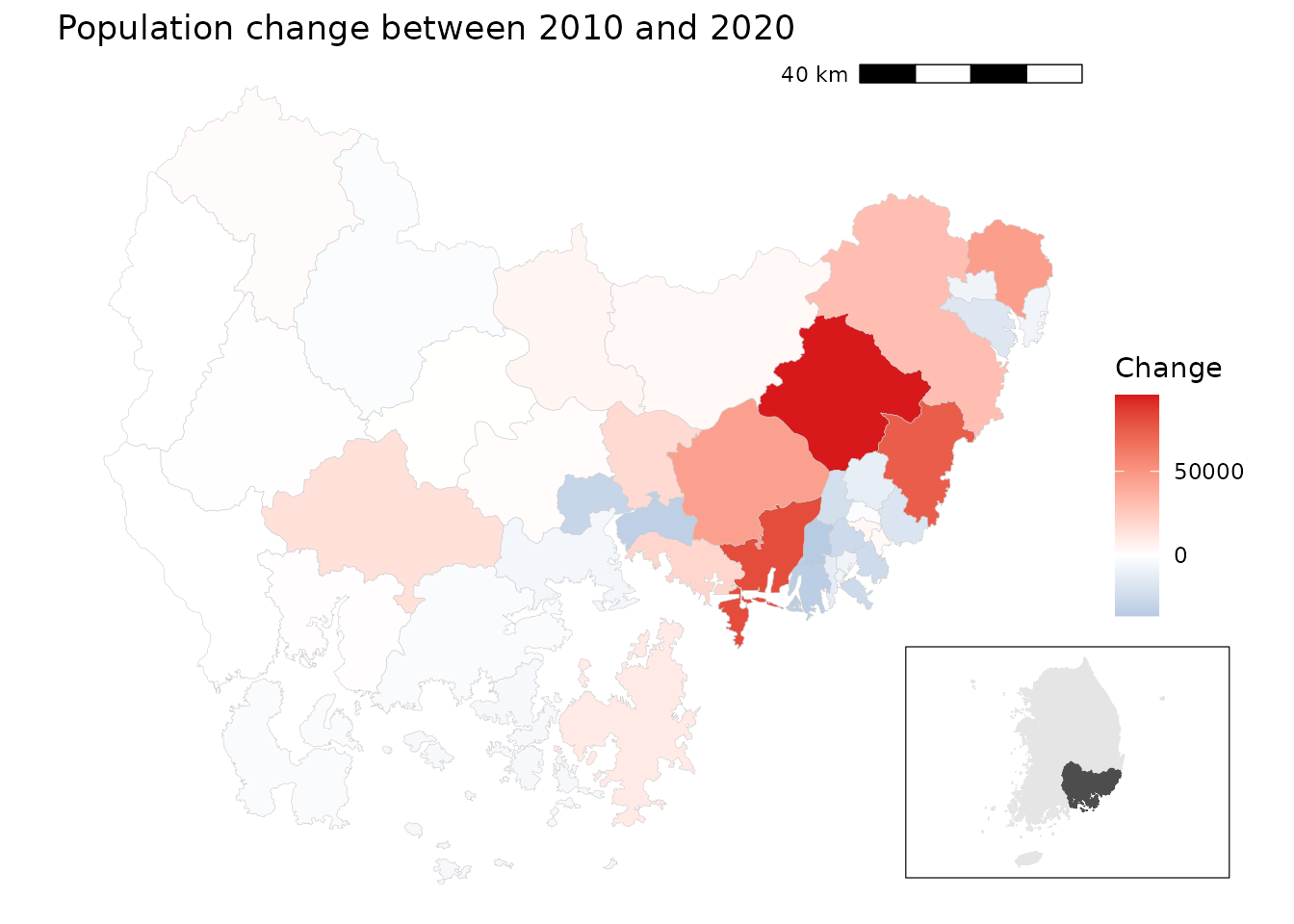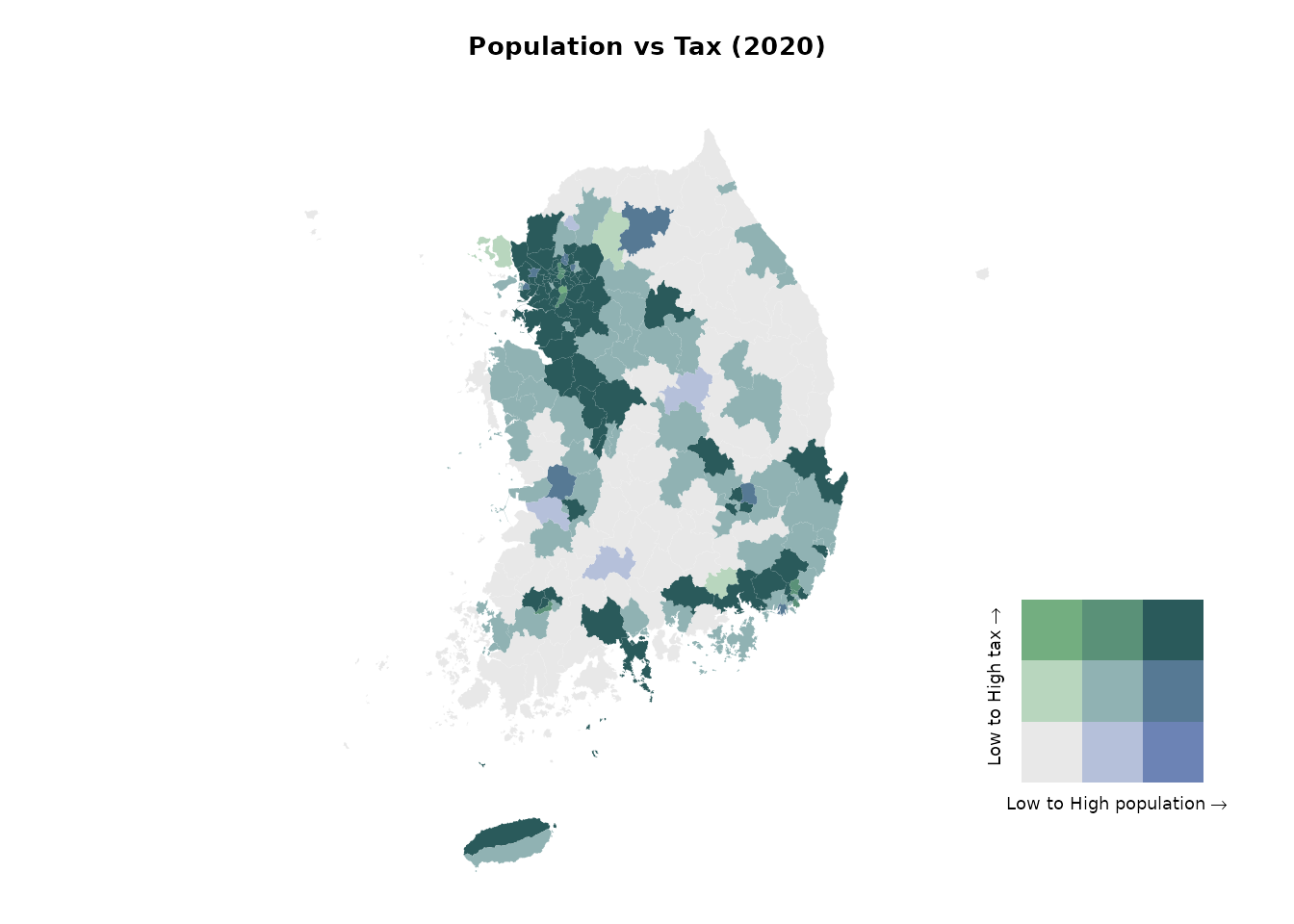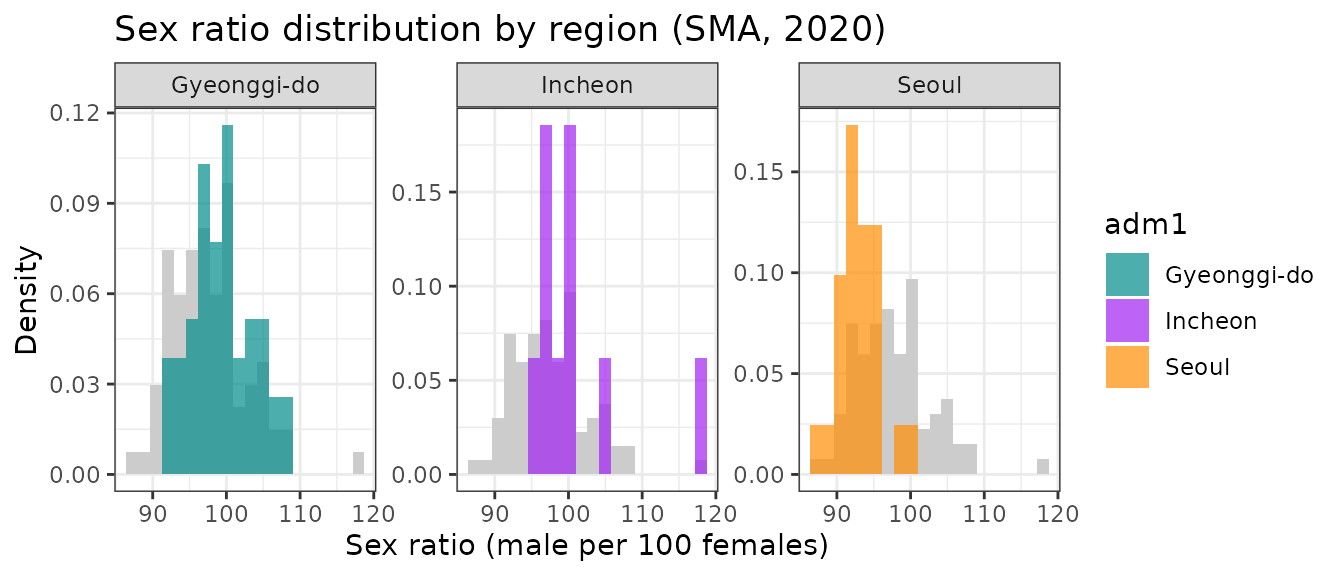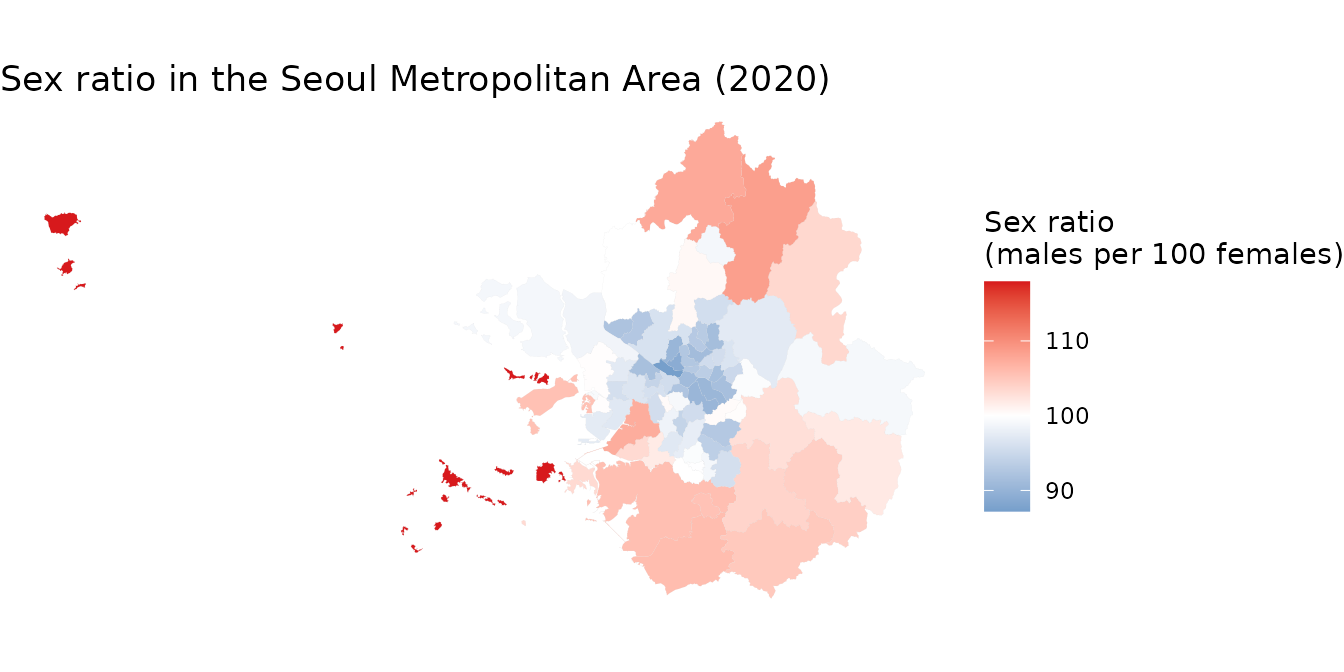Regional analysis with tidycensuskr
September 23, 2025
Source:vignettes/v02_regional_analysis.Rmd
v02_regional_analysis.RmdExample 1: Population change in the Gyeongsangnam-do region
Design idea
- Load 2010 and 2020 census population data.
- Merge with 2020 district boundaries.
- Calculate the population change
(
change = 2020 − 2010). - Subset to Gyeongsangnam-do, Busan, and Ulsan.
- Create a diverging choropleth map to show population increase/decrease, with an inset map of Korea highlighting the region.
Data prep
# Load 2020 boundaries
sf_2020 <- load_districts(year = 2020)
# Load census population data for 2010 and 2020
df_2010_pop <- anycensus(year = 2010,
codes = c("Gyeongsangnam-do", "Busan", "Ulsan"),
type = "population")
df_2020_pop <- anycensus(year = 2020,
codes = c("Gyeongsangnam-do", "Busan", "Ulsan"),
type = "population")
# Merge with spatial data and compute population change
sf_target <- sf_2020 |>
inner_join(df_2010_pop, by = "adm2_code") |>
inner_join(df_2020_pop, by = "adm2_code") |>
mutate(change = `all households_total_prs.y` - `all households_total_prs.x`)A choropleth map with an inset map
# Choropleth map for population change
map <- ggplot(sf_target) +
geom_sf(aes(fill = change), color = "gray80", size = 0.1) +
labs(title = "Population change between 2010 and 2020") +
scale_fill_gradient2(
low = "#2C7BB6", mid = "white", high = "#D7191C",
midpoint = 0,
name = "Change"
) +
theme_void() +
annotation_scale(location = "tr", width_hint = 0.25, text_cex = 0.7, line_width = 0.7)
# National boundary (union of all districts)
sf_korea_boundary <- sf_2020 |>
summarise(geometry = st_union(geometry))
# Target region boundary (union of selected provinces/cities)
sf_target_boundary <- sf_target |>
summarise(geometry = st_union(geometry))
# Inset map: whole Korea + highlighted target region
korea_inset <- ggplot() +
geom_sf(data = sf_korea_boundary, fill = "grey90", color = "grey90") +
geom_sf(data = sf_target_boundary, fill = "grey30", color = "grey30") +
theme_void()
# Combine main map and inset
cowplot::ggdraw() +
cowplot::draw_plot(map) +
cowplot::draw_plot(korea_inset, x = 0.7, y = 0.05, width = 0.25, height = 0.25) +
draw_grob(grid::rectGrob(gp = gpar(col = "black", fill = NA, lwd = 0.6)),
x = 0.7, y = 0.05, width = 0.25, height = 0.25) In the Gyeongsangnam-do region, large metropolitan cities such as Busan
and Ulsan show population decline, while surrounding suburban areas
demonstrate notable population gains. Rural areas in the western part of
the province exhibit relatively stable population trends.
In the Gyeongsangnam-do region, large metropolitan cities such as Busan
and Ulsan show population decline, while surrounding suburban areas
demonstrate notable population gains. Rural areas in the western part of
the province exhibit relatively stable population trends.
Example 2: Bivariate mapping of population vs. tax
Design idea
- Load 2020 population and tax datasets.
- Because tax data is not available at the Gu level of large
cities, aggregate district-level (
adm2_code) data to the 4-digit prefix level. - Merge population and tax data.
- Use
biscale::bi_class()to create a 3×3 bivariate classification of population (x) vs. tax (y). - Draw a bivariate choropleth map with a custom legend.
Data prep
# Load 2020 boundaries
sf_2020 <- load_districts(year = 2020)
# Load census data
df_2020_pop <- anycensus(year = 2020,
type = "population")
df_2020_tax <- anycensus(year = 2020,
type = "tax")
# Merge population with boundaries
sf_2020_pop <- sf_2020 |>
left_join(df_2020_pop, by = "adm2_code") |>
mutate(
adm2_code_chr = as.character(adm2_code),
adm2_prefix4 = substr(adm2_code_chr, 1, 4),
last_digit = substr(adm2_code_chr, 5, 5)
)
# Aggregate smaller units (adm2_code ending not with 0) into 4-digit groups
sf_union_needed <- sf_2020_pop |>
filter(last_digit != "0") |>
group_by(adm2_prefix4) |>
summarise(
across(where(is.numeric), ~ sum(.x, na.rm = TRUE)),
geometry = st_union(geometry),
.groups = "drop"
) |>
mutate(adm2_code = as.numeric(paste0(adm2_prefix4, "0")))
# Combine aggregated units with existing "0"-ending districts
sf_2020_unioned <- sf_2020_pop |>
filter(last_digit == "0") |>
bind_rows(sf_union_needed)
# Join with tax data
sf_final <- sf_2020_unioned |>
left_join(df_2020_tax, by = "adm2_code")A bivariate choropleth map
# Create 3x3 bivariate classes (population vs tax)
bi_data <- bi_class(
sf_final,
x = `all households_total_prs`,
y = income_general_mkr,
style = "quantile",
dim = 3
)
# Bivariate legend
legend <- bi_legend(
pal = "DkCyan", dim = 3,
xlab = "Low to High population",
ylab = "Low to High tax",
size = 7
)
# Mapping
cowplot::ggdraw() +
cowplot::draw_plot(
ggplot() +
geom_sf(data = bi_data, aes(fill = bi_class), color = NA) +
bi_scale_fill(pal = "DkCyan", dim = 3, guide = "none") +
bi_theme() +
labs(title = "Population vs Tax (2020)") +
theme(plot.title = element_text(size = 10))
) +
cowplot::draw_plot(legend, x = 0.7, y = 0.1, width = 0.3, height = 0.3)
The bivariate map highlights the strong centrality of the Seoul Metropolitan Area. Both the capital region and the southeastern manufacturing hubs exhibit high population and high tax revenues. In contrast, most other regions—such as Gangwon and Gyeongbuk, apart from a few metropolitan centers—fall into the low population–low tax category.
Example 3: Sex ratio in Seoul Metropolitan Area
Design idea
- Load 2020 population data for Seoul, Gyeonggi-do, and Incheon.
- Calculate the sex ratio (
male/female × 100). - Visualize the distribution of sex ratios:
- Show the overall distribution as a grey background histogram.
- Overlay regional distributions (Seoul, Incheon, Gyeonggi-do) in color with facets.
- Map the sex ratio across districts, using a diverging color scale centered on 100 (balanced sex ratio).
Data prep
# Load population data for the Seoul Metropolitan Area (SMA)
df_sma <- anycensus(
year = 2020,
codes = c("Seoul", "Gyeonggi-do", "Incheon"),
type = "population"
)
# Calculate sex ratio (males per 100 females)
df_sma <- df_sma |>
mutate(sex_ratio = `all households_male_prs` / `all households_female_prs` * 100)
# Extract overall distribution (all SMA combined)
df_all <- df_sma |>
select(sex_ratio)Histograms
ggplot() +
# Background: overall distribution across all SMA
geom_histogram(
data = df_all,
aes(x = sex_ratio, y = after_stat(density)),
bins = 20, fill = "grey80", color = NA, alpha = 1
) +
# Regional distributions
geom_histogram(
data = df_sma,
aes(x = sex_ratio, y = after_stat(density), fill = adm1),
bins = 20, alpha = 0.7, color = NA, position = "identity"
) +
facet_wrap(~ adm1, ncol = 3, scales = "free_y") +
scale_fill_manual(values = c(
"Seoul" = "darkorange",
"Incheon" = "purple",
"Gyeonggi-do" = "cyan4"
)) +
labs(
title = "Sex ratio distribution by region (SMA, 2020)",
x = "Sex ratio (male per 100 females)",
y = "Density"
) +
theme_bw()
A choropleth map
# Load boundaries
sf_2020 <- load_districts(year = 2020)
# Merge SMA population data with boundaries
sf_2020_sma <- sf_2020 |>
inner_join(df_sma, by = "adm2_code")
# Choropleth map for sex ratio
ggplot(sf_2020_sma) +
geom_sf(aes(fill = sex_ratio), color = "gray", size = 0.01) +
scale_fill_gradient2(
low = "#2C7BB6", mid = "white", high = "#D7191C",
midpoint = 100, # 100 = equal male/female
name = "Sex ratio\n(males per 100 females)"
) +
labs(title = "Sex ratio in the Seoul Metropolitan Area (2020)") +
theme_void()
Within the Seoul Metropolitan Area, the central city districts (Seoul) show a higher proportion of females, whereas the outer suburban areas tend to show male-dominated populations. This highlights spatial differences in gender distribution across the metropolitan region.